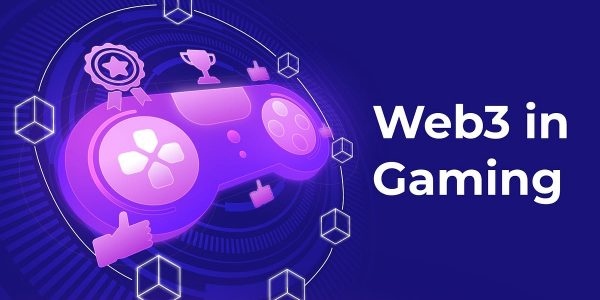The gaming industry has constantly ripened, from Computer Space and the range of arcade titles that follow in the pioneer’s footsteps to the emergence of multiplayer online projects. Nowadays, the world is witnessing important innovations again, given the appearance of cryptocurrencies, Web3, and blockchain, which have transformed how people relate to games.
Players and investors alike have become more interested in cryptocurrencies due to their extraordinary rise in popularity. While Web3 may sound complex and confusing for those unfamiliar with the latest tech trends, players accustomed to checking the Bitcoin price and keeping up to date with crypto-related news are more likely to adapt to the new ecosystem more easily.
It is evident that the advancements made by cryptocurrencies and blockchain in various industries are not about to end. But to what extent can these evolving technologies transform the gaming ecosystem, and what barriers must be overcome to become mainstream?
How blockchain transformed web3 gaming
Blockchain has already made its impact on a host of industries, and now gaming is the one that’s expected to be disrupted. Web3 gaming is all about gaming experiences built on blockchain technology that is transparent, safe, and decentralized. The term may sound hard to grasp for a newbie to gaming or blockchain technology, but it couldn’t be easier to understand. Web3 gaming is a new game that works on blockchain-built decentralized platforms. The essence of the experience is that there’s no need for a central authority to oversee and verify the action.
The newly-introduced games provide a never-seen-before level of security, transparency, and asset ownership that was off the table in the traditional gaming system. Players are able to acquire and invest virtual money while playing games on related gaming platforms, which use it as a medium of exchange and stimulus.
Blockchain’s advantages for Web3 gaming
Despite its complexity and need for constant advancement, blockchain technology has several advantages in web3 gaming, including the following ones.
- Decentralization plays an essential role in blockchain technology. Web3 gaming platforms are decentralized, so they’re out of any other central authority’s control. Without the implication of a supervisor, the system can’t fail, and transparency is guaranteed.
- Transparency is another critical aspect of blockchain technology, which in the Web3 sphere is guaranteed by recording the game results and transactions on the public ledger. This eliminates fraud and cheating and ensures all participants have equal chances of triumph.
- Cryptography and decentralized networks boost the security of the Web3 gaming experience and reduce the risk of fraud and hacks.
- Interoperability is critical in web3 gaming as it permits users to send and utilize their assets across multiple games and platforms and trade them on different decentralized exchanges. This feature is only possible using blockchain networks that enable mutual communication between networks.
- An essential feature of web gaming is the ability of players to store, exchange, sell, or exchange items as they wish. While these actions are not possible in traditional gaming, blockchain technology enables them in the new generation of games. This opportunity empowers users to have an additional vehicle to generate money and stimulates them to maintain high engagement levels.
Cryptocurrency integration is an essential aspect of web3 gaming
Participants can acquire and use digital money as they wish or trade holdings on decentralized exchanges, all while engaging in entertaining activities. This feature brings incentivization and monetization to new levels. Devs can also generate distinctive crypto tokens that can be used in the gaming ecosystem, exchanged on decentralized exchanges, or used to buy in-game services or items.
Cryptocurrencies have several advantages over conventional payment methods. They allow users to acquire and spend money in decentralized settings without the involvement of payment processors, banks, governmental bodies, or other go-betweens. Participants enjoy a greater degree of financial independence and autonomy.
There are also drawbacks to web3 gaming
Web 3 gaming has proven its potential over the years, and its astronomical rise to popularity has stood as proof. However, just like there’s no such thing as a flawless industry, there are also several challenges the sector has to overcome to provide better user experiences, with the following topping the list:
- Difficult onboarding. The process of onboarding participants is probably among the most significant struggles in today’s Web3 gaming sphere. To engage in Web3 games, players must set up and manage digital wallets, which involves working with private keys and seed phrases. The thought of managing critical information puts off many potential users, which builds a high entry barrier. This factor may lastly restrict the number of participants who can play these emerging games and hinder the ecosystem’s development.
- Flawed gaming experience. The fact that games are dispersed across multiple blockchain platforms makes it difficult for participants to discover and play them whenever they wish. This obstacle can put off potential users who want to experience popular titles or engage with new ones but can’t find them easily. Plus, since Web3 games don’t work on centralized platforms, the lack of a universal methodology for creating games can lead to a fragmented user experience.
- Overwhelming requirements. The fact that players must sign transactions for every on-chain activity while engaged in the game impedes Web3 games’ goal of becoming mainstream. This factor interrupts the game’s flow and enables lags, making it frustrating. Blockchain improves transparency and security, but the insistent requirement of signing transactions can discourage players who prefer an error-free and smooth gameplay experience.
The wrap-up
As you can see, blockchain and Web3 have a long way to go before they unlock all of their potential. So far, transparency, enhanced security, and in-game asset ownership are some of the benefits of the new generation of games over the traditional ones. There are incredible opportunities welcomed by Web3 gaming, such as play-to-earn mechanics, cross-game collaboration, interoperability, decentralization, and the monetization of in-game digital assets. As technology progresses, more is expected to come from this area, with new titles breaking into the market.




